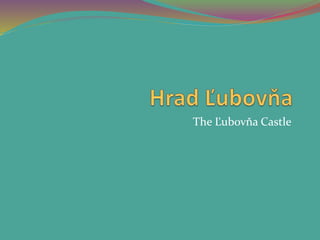Hrad star√° ńĺubovŇąa
- 2. Ôāó nad Starou ńĹubovŇąou v severov√Ĺchodnej ńćasti SpiŇ°a sa na v√°pencovom bralnatom vrchu vysokom 711 m vyp√≠na Hrad ńĹubovŇąa Ôāó on a limestone cliff of 711 m over Star√° ńĹubovŇąa in the north-east of SpiŇ° stands ńĹubovŇąa Castle
- 3. Ôāó v minulosti sa presl√°vil stretnutiami korunovan√Ĺch hl√°v, ukr√Ĺvan√≠m pońĺsk√Ĺch korunovańćn√Ĺch klenotov a v√§znen√≠m M√≥rica BeŇąovsk√©ho, Ň°ńĺachtica, cestovateńĺa a kr√°ńĺa Madagaskaru Ôāó rulers met here in the past, it is the place where Polish coronation jewels were hidden and where famous adventurer, noble man and King of Madagascar, M√≥ric BeŇąovsk√Ĺ was imprisoned
- 4. Ôāó hrad vznikol na rozhran√≠ 13. a 14. storońćia. Hrad ńĹubovŇąa sa v ńćase svojho vzniku zaradil do syst√©mu pohranińćn√Ĺch hradov na severe Uhorska Ôāó the ńĹubovŇąa Castle was built at the turn of the 13thand 14th century, when it became a part of the boundary castles system in the north of the Hungarian Kingdom
- 5. Ôāó okrem ochrany pońĺsko-uhorskej hranice zabezpeńćoval d√īleŇĺit√ļ obchodn√ļ cestu prech√°dzaj√ļcu dolinou rieky Poprad do Pońĺska Ôāó besides the protection of the former Polish-Old Hungarian border, its task was to secure the important trade route passing along the valley of the Poprad river to Poland
- 6. Ôāó v roku 1412 sa v Hrade ńĹubovŇąa uskutońćnilo historick√© stretnutie uhorsk√©ho kr√°ńĺa ŇĹigmunda Luxembursk√©ho s pońĺsk√Ĺm panovn√≠kom Vladislavom II. Ôāó in 1412, the historical meeting of the Old Hungarian ruler Sigismund of Luxembourg with the Polish king Vladislav II took place in the ńĹubovŇąa Castle
- 7. Ôāó hrad sa dostal do z√°lohu pońĺsk√Ĺch kr√°ńĺov a stal sa s√≠dlom pońĺsk√Ĺch starostov, ńćiŇĺe splnomocnen√Ĺch spr√°vcov z√°lohovan√Ĺch spiŇ°sk√Ĺch miest Ôāó the Castle was pledged to Polish kings and became the seat of Polish mayors, i.e. entrusted administrators of pledged SpiŇ° towns
- 8. Ôāó po obrovskom poŇĺiari v roku 1553 z√≠skal Hrad ńĹubovŇąa rozsiahlou prestavbou modernejŇ°iu podobu renesanńćnej pevnosti Ôāó po vr√°ten√≠ spiŇ°sk√Ĺch miest Uhorsku v√Ĺznam hradu klesol, zańćal upadaŇ• a meniŇ• sa na ruinu Ôāó through a reconstruction accomplished after a great fire in 1553, the ńĹubovŇąa Castle obtained a more modern shape of a Renaissance fortress Ôāó after the return of the SpiŇ° towns to Old Hungary, the role of the Castle diminished and the Castle itself fell in decay
- 9. Ôāó v r√°mci obnovy hradu ho √ļspeŇ°ne zrekonŇ°truovali a v s√ļńćasnosti doŇą umiestnili expoz√≠cie hradn√©ho m√ļzea Ôāó v roku 1991 bola obnoven√° a znovu vysv√§ten√° hradn√° kaplnka, v ktorej sa usporad√ļvaj√ļ bohosluŇĺby ‚ÄĘ later on the Castle was successfully reconstructed and the castle museum exhibitions have been installed there ‚ÄĘ in 1991, the castle chapel was reconstructed and re-consecrated ‚ÄĘ regular church services are still held there
- 10. Ôāó samostatn√ļ muze√°lnu expoz√≠ciu predstavuje skanzen v podhrad√≠ Ôāó an independent museum exhibition is presented by an open air museum in the area at the foot of the castle hill
- 11. Ôāó tvor√≠ ho s√ļbor ńĺudov√Ĺch stavieb, ktor√Ĺ pripom√≠na malebn√ļ podhradsk√ļ osadu Ôāó it consists of a set of folk buildings that form a picturesque settlement around the Castle










